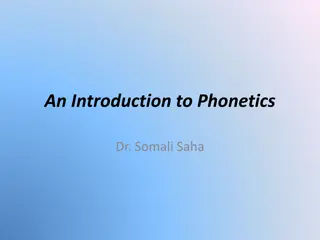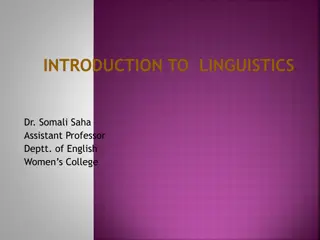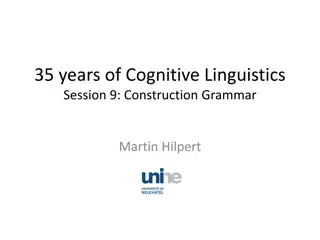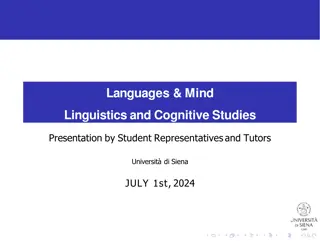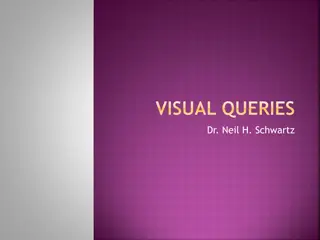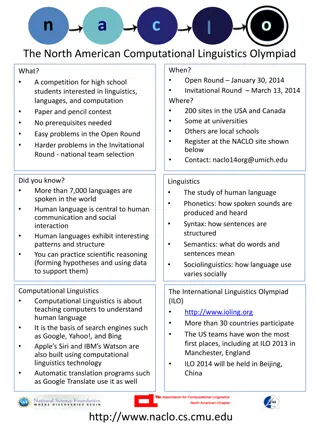Understanding the Fundamentals of Linguistics: A Visual Overview
Explore the key elements of language, from phonetics and phonology to morphology, syntax, semantics, and pragmatics. Delve into the study of individual speech sounds, word structure, and the rules governing sentence structure. Discover how meaning is conveyed through words and sentences, and how context shapes language use and communication. Gain insights into the major levels of linguistics and the importance of grammar and lexicon.
Uploaded on Sep 16, 2024 | 0 Views
Download Presentation

Please find below an Image/Link to download the presentation.
The content on the website is provided AS IS for your information and personal use only. It may not be sold, licensed, or shared on other websites without obtaining consent from the author. Download presentation by click this link. If you encounter any issues during the download, it is possible that the publisher has removed the file from their server.
E N D
Presentation Transcript
Lingua Inglese Tecniche di Laboratorio Biomedico A.A. 2022-2023
2 Language is the ability to produce and comprehend spoken and written words. Elements of a language Linguistics is the study of language.
3 Phonetics / Phonology Morphology The structure of a language has several levels Syntax Semantics Pragmatics
4 Phonetics is the study of individual speech sounds (all the sounds a human being can make). Phonology is the study of phonemes1: the speech sounds of a language (i.e. which sounds make up different languages). Language begins with sounds 1A phoneme is the smallest unit of sound that may cause a change of meaning within a language, but that doesn t have meaning by itself.
5 Morphology: the study of words, their structure, and other meaningful units of language like suffixes and prefixes. Sounds create words The basic unit of morphology are morphemes1. 1The smallest linguistic unit within a word that can carry a meaning.
6 Syntax is the set of rules, principles, and processes that govern the structure of sentences in a given language, specifically word order. Words are quite useless unless they are combined to form sentences Every language has a different set of syntactic rules, but all languages have some form of syntax.
7 Semantics is about the meaning of sentences. It analyzes words and what real-world objects or concepts those words stand for. Meaning resides in words, sentences and their combination By using grammatical rules to combine words into logical sentences, humans can convey an infinite number of concepts. It is the study of meaning in the human language.
8 Pragmatics is the language in use. Meaningful communication among individuals Context is how everything within language works together to convey a certain meaning, including tone of voice and body language.
9 Major levels of linguistics
10 Grammar Lexicon Two of the concepts that make language unique are grammar and lexicon Grammar is a set of rules for generating logical communication. Every human language has a lexicon the sum total of all of the words in that language. Speakers of a language have internalized the rules and exceptions for that language s grammar.
11 11 The importance of language Language shapes our social interactions and brings order to our lives. Complex language is one of the defining factors that makes us human.
12 12 The importance of context How important is context to reading? Extremely! In the 1970s, a famous study was conducted by Bransford and Johnson. Participants were asked to listen to a passage and then answer questions. The passage was similar to the following. Take a minute to read it:
13 The importance of context This is a fairly easy process. It can be completed at home or at a different place if the necessary machinery isn t available. First, items are put into different groups. But if there isn t too much to deal with, one group may be enough. It s important to look at everything carefully: a mistake could ruin a group. This first phase doesn t take very long, especially the more times you do it. The next phase goes faster. Once it is taken care of, it won t require your attention until it is finished. At that point, the items will be separated again. These groups will determine where everything goes. Once things are put away, you have finished until the process is repeated the next time.
14 Did the reading make sense to you? If you were confused, you are not alone. It s difficult to make sense of. Then participants were given the title: Washing Clothes and asked to read it again. Try this now. As you can see, context makes a significant difference. That is why you have probably already learned how helpful it is to look at chapter heads and subheads when you are reading a textbook. And don t forget to look at photos and other illustrations even before you start to read or do an exercise. All of this information will help you read more efficiently.
16 16 Learning English may be a difficult task, but it doesn t need to be a frightening experience






